Watches & Wonders 2023 has been a great show for the main maisons. Patek Philippe had new versions of the ref. 6300 Grandmaster Chime, Vacheron Constantin produced another wonder in their Cabinotiers series, and Roger Dubuis introduced a new idea into its hyper horology universe with some justification, re-thinking the tourbillon and micro-rotor winding system with two patented devices in their Monovortex concept watch. All exemplary illustrations of haute horlogerie at its finest.
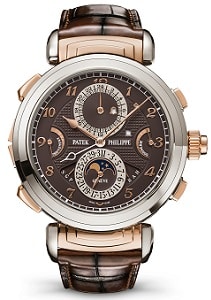


Left to right: Patek Philippe ref. 6300 Grandmaster Chime, Vacheron Constantin Les Cabinotiers Dual Moon Grand Complication, Roger Dubuis Monovortex™ Split-Seconds Chronograph.
However, there were three other watches that caught my eye, not only for their horological value but also for their design codes and aesthetic forms shaped some time ago; proof positive that good style never goes out of fashion.
First was the Patek Philippe Calatrava ref. 5224R (£46,190). There were a number of new references in Patek’s longest running watch series – including a triple set of sport black dials with brightly coloured accents – but this one, with its inspiration from the 24-hour pocket watches once manufactured for Gondolo & Labouriau, Rio de Janeiro, stood out. Gongolo & Labouriau were a special part of Patek Philippe’s history, selling watches through the retailer’s club raffle system and, at one stage during the 1920s, accounted for approximately a third of sales.


The dial of the new Patek ref. 5224R (left) takes its inspiration from the pocket watches produced for Gongolo & Labouriau a century ago (right).
The new reference incorporates a travel time function as well. Once you get used to the 24-hour dial, it makes understanding the time in two different parts of the world that much easier, as you no longer need a day/night indicator for the second time zone. Time setting is via the crown with a new three-step patent-protected mechanism. The navy-blue dial features a double railway-track scale for the hours and minutes, with alternating Arabic numerals and hour markers; and is superbly legible. A re-worked 31-260 ultra-thin self-winding base calibre, adding the 24-hour and the travel time mechanism, lies beneath the dial, all housed in a 42mm rose gold case. Elegant and functional, everything that Chronometro Gondolo was and is.
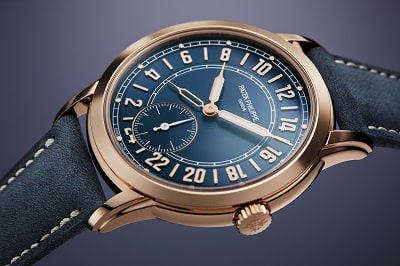
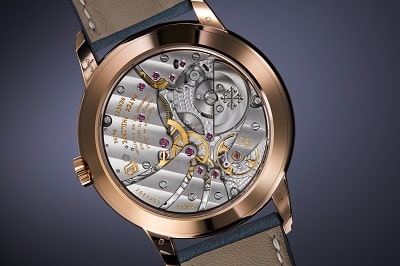
Beneath the navy-blue dial lies a re-worked 31-260 ultra-thin self-winding base calibre, adding the 24-hour and the travel time mechanism.
The next up is Vacheron Constantin’s steel Overseas sports watch with a retrograde calendar and moon phase. It features an iridescent blue lacquered dial that shimmers, depending on the light, thanks to the sunburst satin-brushed finish. The dial features luminescent hour-markers and hands, with the moon-phase displayed through an aperture at six o’clock, graduated from zero to 29½ detailing the approximate age of the moon in days, where the precision mechanism requires a one-day correction every 122 years. The retrograde date indication is via a central hand that occupies the upper part of the dial.
The Overseas, designed by Vincent Kaufmann and external watch artist Dino Modolo, was initially introduced in 1996 as the direct descendent of the Jorg Hysek designed 222, which Vacheron Constantin re-introduced last year. The first Overseas by name was intended to have a more general appeal than the single model form that the 222 represented. It was broadly the same dimensions but had improved water resistance (at 150 metres) and used an automatic movement.
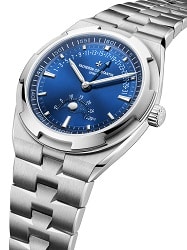
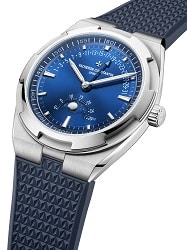
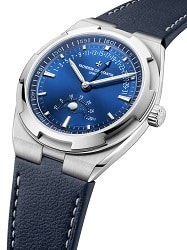
The Vacheron Constantin Overseas Moon Phase shown with its three easily interchangeable straps: metal bracelet (left), rubber strap (middle), and leather strap (right).
The present enhanced, more muscular form for the Overseas, dates back to 2004, and has been subtly improved over time, looking slightly more robust and imposing on the wrist, with the introduction of the half-Maltese cross metal bracelet and same motif featured on the bezel. The Overseas now features a Faraday cage with anti-magnetic properties, and the more robust construction allows the watch to have a more active role in day-to-day life.
Powered by the automatic calibre ref. 2460 R31L/2, its decorated gold oscillating weight can be viewed through the display back. Thanks to its folding clasp and three straps – steel, leather, and rubber – and self-interchangeable system, the watch can be personalized according to your own whim. Only available through boutiques.
Cartier’s stand out offering this year in their Privé line was a re-issue of the Tank Normale in two platinum version. It is testimony to Louis Cartier’s genius that the design has lost none of its modernity or presence. His genius also extended to the use of this rare and precious metal, which he left looking ordinary and sculpted in the form of a World War I Renault tank. Platinum was – and still is – very scarce. So much so that during World War II, the US government went as far as to ban its use for anything other than the national interest.
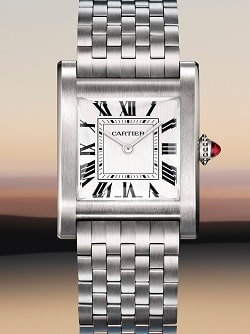
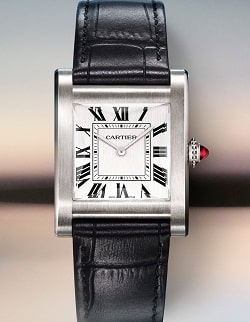
The two versions of the new Cartier Tank Normale, in all platinum case and bracelet (left), and on an alligator strap (right), both with the traditional ruby cabochon on the crown.
The two versions launched at Watches & Wonders are available with and without a matching bracelet. The one on a leather strap is a limited edition of 200; the all-platinum case and bracelet is limited to 100 pieces. Cartier has followed historical precedent by using the hand-wound calibre 070, the smallest movement available to the brand through Le Temps Manufacture. The dimensions and form for the watch are approximately the same as a century ago, the brushed silver dial design with its secret signature on the V in VII, and the railroad track hashes around the inside, the shape of the crystal, and the ruby cabochon, all make this year’s Tank Normale an instant classic.
Words: Dr Andrew Hildreth














Show Comments +